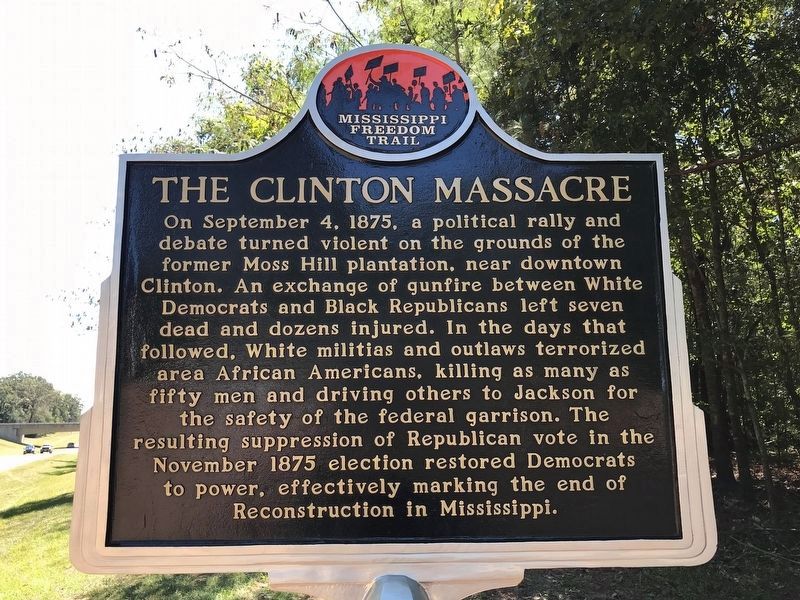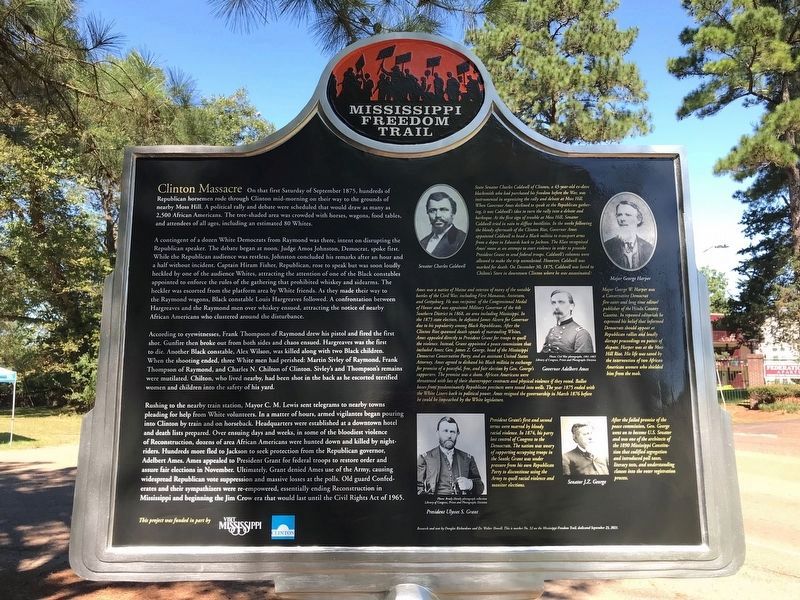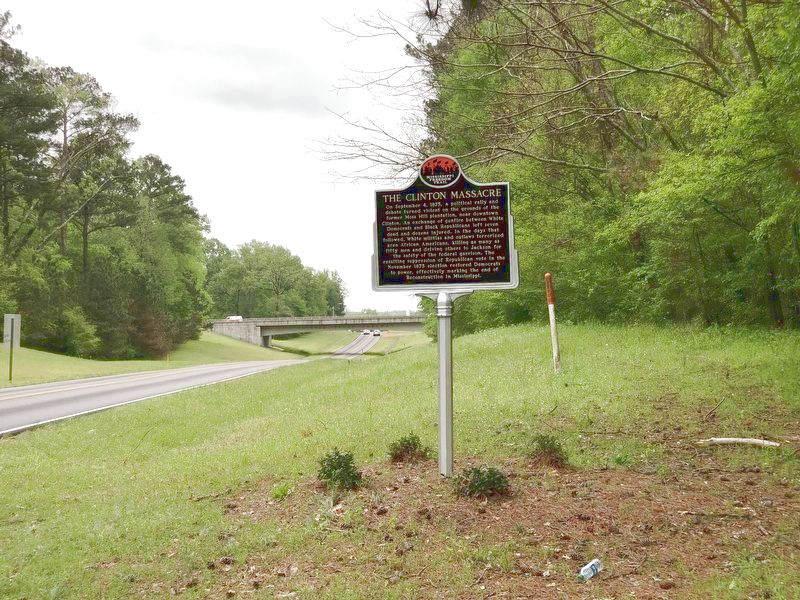Clinton in Hinds County, Mississippi — The American South (East South Central)
The Clinton Massacre
— Mississippi Freedom Trail —
On September 4, 1875, a political rally and debate turned violent on the grounds of the former Moss Hill plantation, near downtown Clinton. An exchange of gunfire between White Democrats and Black Republicans left seven dead and dozens injured. In the days that followed. White militias and outlaws terrorized area African Americans, killing as many as fifty men and driving others to Jackson for the safety of the federal garrison. The resulting suppression of Republican vote in the November 1875 election restored Democrats to power, effectively marking the end of Reconstruction in Mississippi.
Clinton Massacre On that first Saturday of September 1875, hundreds of Republican horsemen rode through Clinton mid-morning on their way to the grounds of nearby Moss Hill. A political rally and debate were scheduled that would draw as many as 2,500 African Americans. The tree-shaded area was crowded with horses, wagons, food tables, and attendees of all ages, including an estimated 80 Whites.
A contingent of a dozen White Democrats from Raymond was there, intent on disrupting the Republican speaker. The debate began at noon. Judge Amos Johnston, Democrat, spoke first. While the Republican audience was restless, Johnston concluded his remarks after an hour and a half without incident. Captain Hiram Fisher, Republican, rose to speak but was soon loudly heckled by one of the audience Whites, attracting the attention of one of the Black constables appointed to enforce the rules of the gathering that prohibited whiskey and sidearms. The heckler was escorted from the platform area by White friends. As they made their way to the Raymond wagons, Black constable Louis Hargreaves followed. A confrontation between Hargreaves and the Raymond men over whiskey ensued, attracting the notice of nearby African Americans who clustered around the disturbance.
According to eyewitnesses, Frank Thompson of Raymond drew his pistol and fired the first shot. Gunfire then broke out from both sides and chaos ensued. Hargreaves was the first to die. Another Black constable, Alex Wilson, was killed along with two Black children. When the shooting ended, three White men had perished: Martin Sivley of Raymond, Frank Thompson of Raymond, and Charles N. Chilton of Clinton. Sivley's and Thompson's remains were mutilated. Chilton, who lived nearby, had been shot in the back as he escorted terrified women and children into the safety of his yard.
Rushing to the nearby train station, Mayor C. M. Lewis sent telegrams to nearby towns pleading for help from White volunteers. In a matter of hours, armed vigilantes began pouring into Clinton by train and on horseback. Headquarters were established at a downtown hotel and death lists prepared. Over ensuing days and weeks, in some of the bloodiest violence of Reconstruction, dozens of area African Americans were hunted down and killed by night-riders. Hundreds more fled to Jackson to seek protection from the Republican governor, Adelbert Ames. Ames appealed to President Grant for federal troops to restore order and assure fair elections in November. Ultimately, Grant denied Ames use of the Army, causing widespread Republican vote suppression and massive losses at the polls. Old guard Confederates and their sympathizers were re-empowered, essentially ending Reconstruction in Mississippi and beginning the Jim Crow era that would last until the Civil Rights Act of 1965.
Photo captions:
Senator Charles Caldwell
State Senator Charles Caldwell of Clinton, a 43-year-old ex-slave blacksmith who had purchased his freedom before the War, was instrumental in organizing the rally and debate at Moss Hill. When Governor Ames declined to speak at the Republican gather- ing, it was Caldwell's idea to turn the rally into a debate and barbecue. At the first sign of trouble at Moss Hill, Senator Caldwell tried in vain to diffuse hostilities. In the weeks following the bloody aftermath of the Clinton Riot, Governor Ames appointed Caldwell to head a Black militia to transport arms from a depot in Edwards back to Jackson. The Klan recognized Ames' move as an attempt to start violence in order to provoke President Grant to send federal troops. Caldwell's columns were allowed to make the trip unmolested. However, Caldwell was marked for death. On December 30, 1875, Caldwell was lured to Chilton's Store in downtown Clinton where he was assassinated.
General Adlebert Ames
Ames was a native of Maine and veteran of many of the notable battles of the Civil War, including First Manassas, Antietam, and Gettysburg. He was recipient of the Congressional Medal of Honor and was appointed Military Governor of the 4th Southern District in 1868, an area including Mississippi. In the 1873 state election, he defeated James Alcorn for Governor due to his popularity among Black Republicans. After the Clinton Riot spawned death squads of marauding Whites, Ames appealed directly to President Grant for troops to quell the violence. Instead, Grant appointed a peace commission that included Ames; Gen. James Z. George, head of the Mississippi Democrat Conservative Party; and an assistant United States Attorney. Ames agreed to disband his Black militia in exchange for promise of a peaceful, free, and fair election by Gen. George's supporters. The promise was a sham. African Americans were threatened with loss of their sharecropper contracts and physical violence if they voted. Ballot boxes from predominantly Republican precincts were tossed into wells. The year 1875 ended with the White Liners back in political power. Ames resigned the governorship in March 1876 before he could be impeached by the White legislature.
President Ulysses S. Grant
President Grant's first and second terms were marred by bloody racial violence. In 1874, his party lost control of Congress to the Democrats. The nation was weary of supporting occupying troops in the South; Grant was under pressure from his own Republican Party to discontinue using the Army to quell racial violence and monitor elections.
Major George Harper
Major George W. Harper was a Conservative Democrat fire-eater and long time editor/ publisher of the Hinds County Gazette. In repeated editorials he expressed his belief that informed Democrats should appear at Republican rallies and loudly disrupt proceedings on points of dispute. Harper was at the Moss Hill Riot. His life was saved by the intervention of two African American women who shielded him from the mob.
Senator J.Z. George
After the failed promise of the peace commission, Gen. George went on to become U.S. Senator and was one of the architects of the 1890 Mississippi Constitution that codified segregation and introduced poll taxes, literacy tests, and understanding clauses into the voter registration process.
Erected 2021 by Visit Mississippi, City of Clinton. (Marker Number 32.)
Topics and series. This historical marker is listed in this topic list: African Americans. In addition, it is included in the Former U.S. Presidents: #18 Ulysses S. Grant, and the Mississippi Freedom Trail series lists. A significant historical month for this entry is March 1876.
Location. 32° 21.37′ N, 90° 20.042′ W. Marker is in Clinton, Mississippi, in Hinds County. Marker is on West Northside Drive, 0.2 miles west of Vernon Road, on the left when traveling west. Touch for map. Marker is at or near this postal address: W Northside Dr, Clinton MS 39056, United States of America. Touch for directions.
Other nearby markers. At least 8 other markers are within 2 miles of this marker, measured as the crow flies. From the Church to the Blues: A Clinton Legacy (approx. ¼ mile away); Cowles Mead Cemetery (approx. 0.4 miles away); The Clinton Riot (approx. 0.9 miles away); Town Spring (approx. one mile away); The Spring Hotel (approx. one mile away); a different marker also named Town Spring (approx. one mile away); Charles Caldwell Assassination (approx. 1.1 miles away); Clinton's Brick Streets (approx. 1.1 miles away). Touch for a list and map of all markers in Clinton.
Also see . . . The Clinton Courier article - City unveils Clinton Massacre marker. Includes photos of the dedication ceremony and the program. (Submitted on October 25, 2021, by Mark Hilton of Montgomery, Alabama.)
Credits. This page was last revised on June 23, 2023. It was originally submitted on October 25, 2021, by Mark Hilton of Montgomery, Alabama. This page has been viewed 774 times since then and 114 times this year. Photos: 1, 2. submitted on October 25, 2021. 3. submitted on April 3, 2023, by Duane and Tracy Marsteller of Murfreesboro, Tennessee.


